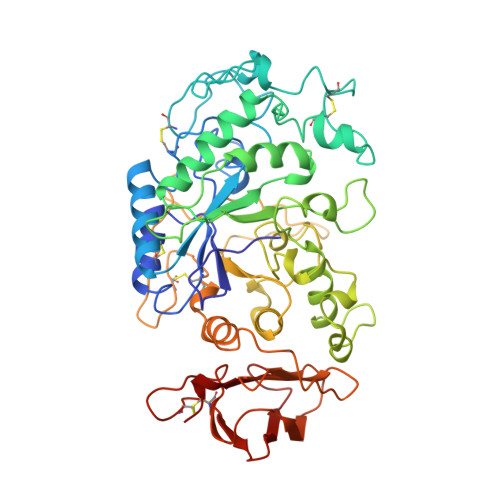The crystal structure of porcine pancreatic alpha-amylase in complex with the microbial inhibitor Tendamistat.
Wiegand, G., Epp, O., Huber, R.(1995) J Mol Biology 247: 99-110
- PubMed: 7897663
- DOI: https://doi.org/10.1006/jmbi.1994.0125
- Primary Citation of Related Structures:
1BVN - PubMed Abstract:
The crystal structure of the complex formed between the 498 amino acid residue porcine pancreatic alpha-amylase (PPA) and the 74 amino acid residue inhibitor Tendamistat secreted from Streptomyces tendae, has been determined by multiple isomorphous replacement in a crystal of space group P6(5)22 (a = b = 77.7 A, c = 359.5 A). The model has been refined to an R-factor of 0.194 by Powell minimization applying strong energy constraints based on 17,964 independent reflections in the 7 to 2.5 A resolution range, and obeys standard geometry within 0.011 A in bond lengths and 1.78 degrees in bond angles. The final model consists of all 496 amino acid residues of PPA, 71 amino acid residues of Tendamistat (without the three N-terminal residues), one calcium ion, one chloride ion and 167 water molecules. PPA exhibits the same topological fold in the complex as the uncomplexed PPA recently published by others. About 30% of the water-accessible surface of Tendamistat is in contact with PPA. Four segments of the polypeptide chain, with a total of 15 amino acid residues, are involved in the binding. One segment containing the staggered side-chains of the triplet Trp18, Arg19, Tyr20, typical for this class of inhibitors, binds into the catalytic site. The other segments fill out the groove in the PPA molecule, which also binds the carbohydrate inhibitor acarbose and is assumed to be the substrate-binding region. This extended interaction between Tendamistat and alpha-amylase explains the very high inhibition constant of about 9 x 10(-12) M.
Organizational Affiliation:
Max-Planck-Institut f¨¹r Biochemie, Martinsried, F.R.G.



















